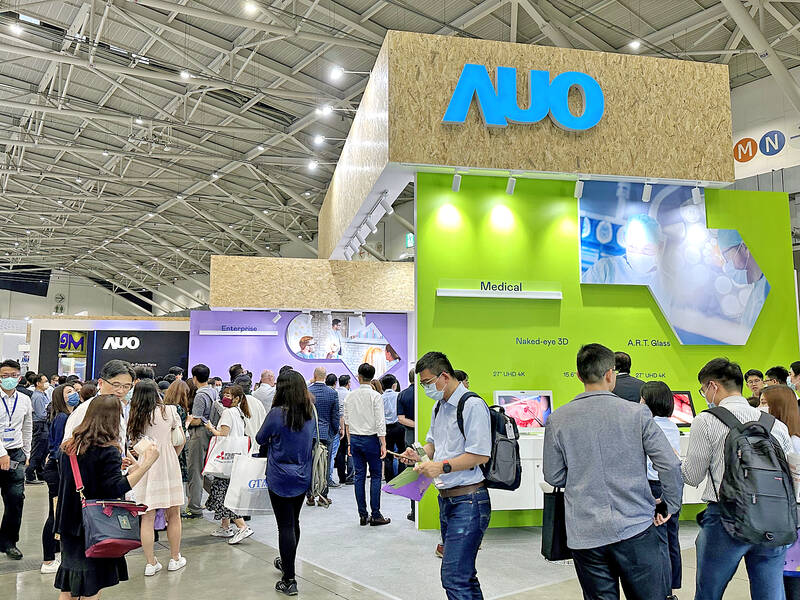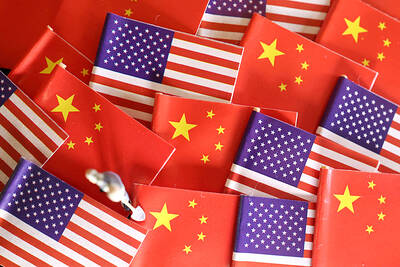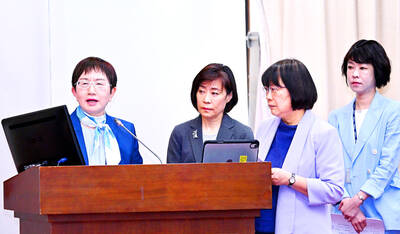Flat-panel maker AUO Corp (友達) yesterday posted its smallest quarterly loss in about five quarters as customers restocked ahead of shopping seasons, and demand for TVs and notebook computers emerged from two years of corrections.
AUO’s net losses improved to NT$975 million (US$30.07 million) in the quarter ended Sept. 30, compared with losses of NT$10.91 billion in the second quarter and NT$10.43 billion in the third quarter last year.
Gross margin rose to 7.6 percent last quarter from 3.1 percent the previous quarter and minus-14.6 percent in the same period last year.

Photo: Chen Mei-ying, Taipei Times
Shipments climbed 3 percent sequentially last quarter, driven by seasonal demand, the company said.
Average selling prices jumped 5 percent quarter-on-quarter to US$329 per square meter, the first uptick since the first quarter.
This quarter, shipments of computer and TV panels would dip about 15 percent sequentially as restocking demand among customers is approaching an end, AUO said.
The upward trend of average selling prices would extend into this quarter with a quarterly increase of 2 to 3 percent, the company said.
“The seasonal restocking demand is to phase out in the second half of the fourth quarter,” AUO chairman Paul Peng (彭?浪) told investors during a quarterly meeting yesterday. “Consumer demand for end devices is expected to remain weak for a period of time because of lingering macroeconomic pressure. Key interest rates in the US are still very high.”
The bright spot is that demand and supply dynamics in the flat-panel industry are moving in a positive direction, with channel inventory returning to healthy levels, while TV and PC brand vendors are taking a prudent approach to manage inventory, Peng said.
Most panel manufacturers have adjusted their equipment utilization to match demand, he said.
AUO said its factory utilization was 80 percent last quarter, but it planned to lower it this quarter as demand declines.
The company yesterday trimmed its capital spending plan for this year by about 14 percent to NT$30 billion, compared with an estimate of NT$35 billion three months ago.
AUO said it would only spend on next-generation display technology, not on expanding capacity.
With years of investment, its micro-LED technology would be commercialized by the end of this year, with shipments to start for use in smart watches, it said.
The next applications for the new display technology would be premium TVs and vehicles, AUO said.
To facilitate the production of micro-LED panels, AUO’s board of directors yesterday approved an investment of NT$700 million to build a 6-inch micro-LED chip-on-carrier production line in Taoyuan’s Longtan District (龍潭) with subsidiary PlayNitride Inc (錼創).
AUO yesterday provided additional details about its ambition to become a major supplier of intelligent cockpit operation systems by acquiring Germany’s Behr-Hella Thermocontrol GmbH.
AUO supplies flat panels used in vehicles, as well as modules integrated with touch and human-machine-interface (HMI) features.
It said it expects revenue from displays with HMI features to make up about 25 percent of its revenue from automotive displays in 2025, up from 10 percent this year, driven by the uptake of electric and autonomous vehicles.

‘SWASTICAR’: Tesla CEO Elon Musk’s close association with Donald Trump has prompted opponents to brand him a ‘Nazi’ and resulted in a dramatic drop in sales Demonstrators descended on Tesla Inc dealerships across the US, and in Europe and Canada on Saturday to protest company chief Elon Musk, who has amassed extraordinary power as a top adviser to US President Donald Trump. Waving signs with messages such as “Musk is stealing our money” and “Reclaim our country,” the protests largely took place peacefully following fiery episodes of vandalism on Tesla vehicles, dealerships and other facilities in recent weeks that US officials have denounced as terrorism. Hundreds rallied on Saturday outside the Tesla dealership in Manhattan. Some blasted Musk, the world’s richest man, while others demanded the shuttering of his

ADVERSARIES: The new list includes 11 entities in China and one in Taiwan, which is a local branch of Chinese cloud computing firm Inspur Group The US added dozens of entities to a trade blacklist on Tuesday, the US Department of Commerce said, in part to disrupt Beijing’s artificial intelligence (AI) and advanced computing capabilities. The action affects 80 entities from countries including China, the United Arab Emirates and Iran, with the commerce department citing their “activities contrary to US national security and foreign policy.” Those added to the “entity list” are restricted from obtaining US items and technologies without government authorization. “We will not allow adversaries to exploit American technology to bolster their own militaries and threaten American lives,” US Secretary of Commerce Howard Lutnick said. The entities

Minister of Finance Chuang Tsui-yun (莊翠雲) yesterday told lawmakers that she “would not speculate,” but a “response plan” has been prepared in case Taiwan is targeted by US President Donald Trump’s reciprocal tariffs, which are to be announced on Wednesday next week. The Trump administration, including US Secretary of the Treasury Scott Bessent, has said that much of the proposed reciprocal tariffs would focus on the 15 countries that have the highest trade surpluses with the US. Bessent has referred to those countries as the “dirty 15,” but has not named them. Last year, Taiwan’s US$73.9 billion trade surplus with the US

Prices of gasoline and diesel products at domestic gas stations are to fall NT$0.2 and NT$0.1 per liter respectively this week, even though international crude oil prices rose last week, CPC Corp, Taiwan (台灣中油) and Formosa Petrochemical Corp (台塑石化) said yesterday. International crude oil prices continued rising last week, as the US Energy Information Administration reported a larger-than-expected drop in US commercial crude oil inventories, CPC said in a statement. Based on the company’s floating oil price formula, the cost of crude oil rose 2.38 percent last week from a week earlier, it said. News that US President Donald Trump plans a “secondary